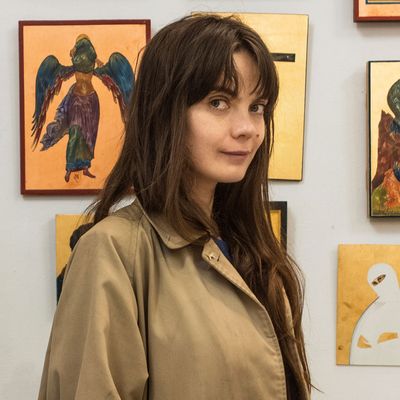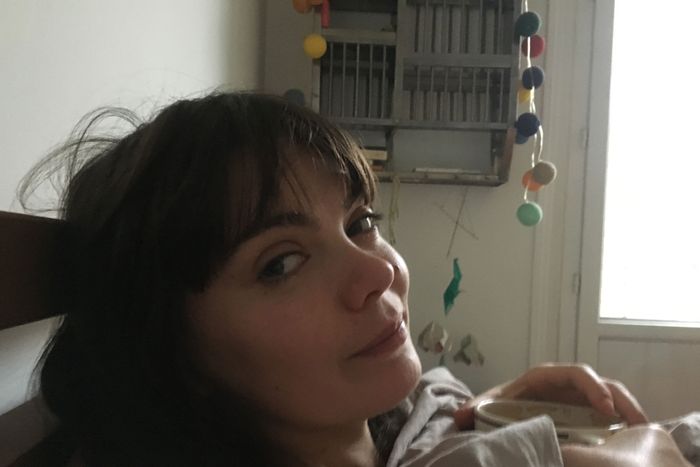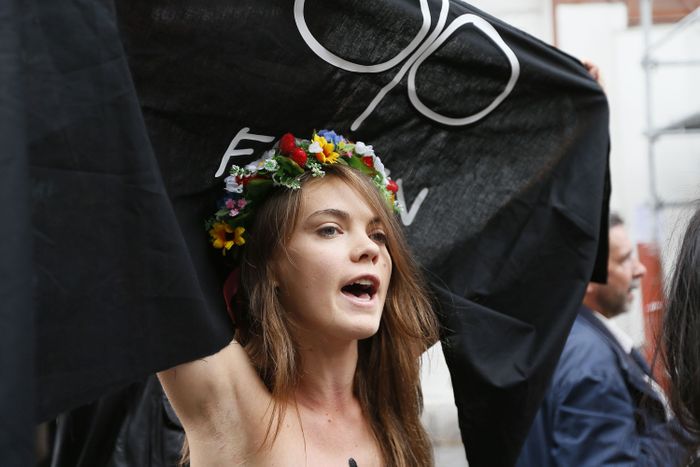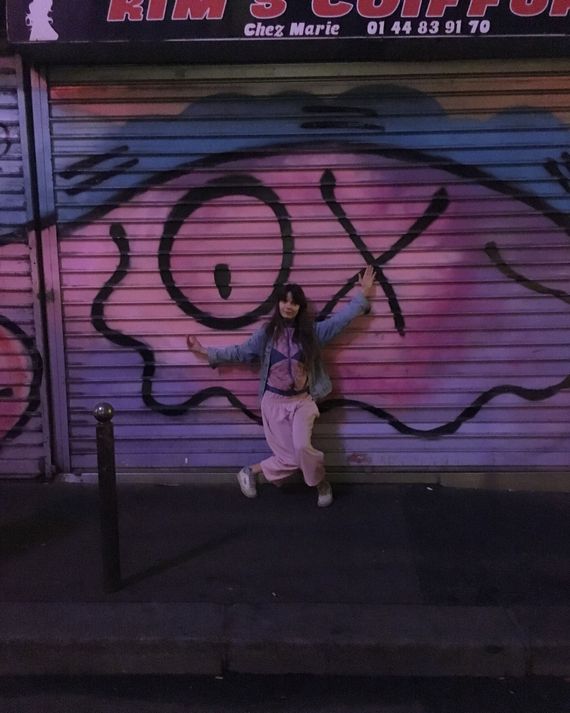
Oksana Shachko was a Ukrainian artist and activist who took her own life in her apartment near Paris this past July. Shachko, 31, was a co-founder of the protest-performance collective Femen (although they later became estranged). She and the writer of this remembrance, Nicholas Mir Chaikin, an artist and creative director from Brooklyn living in Paris, had been lovers and friends.
The last time I saw Oksana Shachko was this past July. She left me standing in front of a bar in the Marais where we had agreed upon a nightcap before returning to my apartment. Earlier, we had been drinking wine and talking with her friend Masha from a perch on the edge of the Seine, where we would often meet. Standing in front of that bar, she suffered one of her frequent and seemingly inexplicable panic attacks, and within 15 seconds she was gone, into the night.
2008. Ukraine was in a state of emergency. As in all states of emergency, countermeasures must be radical. Ukraine was mired in the kleptocratic post-Soviet mobster-run economy. Public resources, which included just about everything, went to strongmen for fractions upon fractions of their worth. There was no public forum about how these vast swathes of public wealth should be used; instead, they went into private pockets. Infrastructure collapsed, and with it, the fabric of society was left flapping and tattered. Poverty and alcoholism emerged as primary pastimes while a new chainmaille of brutal power and enormous wealth concentration was woven over the population’s heads. It was choking them.
This was the context of Oksana’s childhood. As she told the tale: Her father, a factory worker and coin collector, lost his job. His life became a drinking, synapse-rotting sedentary one. He was lulled into a state of nothingness. Her mother was also fired from the factory making propaganda posters where she was an artist in the 1980s. She later found work as a salesperson in a small electronics store, keeping the family alive on one income. Around the country, anything that was being held together was mostly held by women, less prone to throw themselves into the void of uselessness and depression — there were children to feed, and hopefully, lives to rebuild. The vicious neoliberal agenda that helped to “tear down that wall” had not been tempered by anything at all, and a necro-capitalism spread through a once prosperous nation. Lives were shattered, but “communism” had been defeated! Rah!
In that psychic and literal rubble, Ukraine’s new millennials were forged. Some sought meaning in various flavors of ultranationalism. Some immediately turned to substance and alcohol abuse — no doubt existentially despairing of the bludgeoned lives and walking corpses they saw around them. While others turned to more practical solutions, organizing groups and actions, recognizing a value in the commons that had been stolen from them as infants. Oksana was in the latter group. A “young communist” — a label she found amusing because of the “young” stipulation, as if young people can not simply be communists — she joined with other “youth” in her native Khmelnytskyi to organize. There was every problem to address. Some were urgent. Among the urgencies was the emerging sex-slavery economy — some forced, some ostensibly voluntary.
One evening, early in my relationship with Oksana, a friend was visiting my apartment, despairing of a complex and painful relationship. Oksana and I attempted to console her, offering a spare bedroom, and sympathy. Later in the evening there was a ruckus in the hall. I left the bedroom to find the friend, with knife in hand, slicing at her wrists ineffectually, but drawing blood. Oksana, her face gravely serious, came to observe the scene. “Die? You want to die? Just fucking die then.” She proceeded to open the floor-to-ceiling windows and climbed over the balcony railing. She lodged her feet against the outside edge of my tiny balcony, and folding her body into a V-shape, she swung back and forth above the void, four high Haussmannian floors above the sidewalk. “This is how you die! You want I let go?” I was terrified and begging her to come back inside. The visiting friend stopped toying with suicide.
Oksana was an artist, trained from 8 years old by a master iconographer. She was heralded as a prodigy, doing “public” work in churches and selling icons by age 12. The highly coded and symbolic language of the icons were absorbed as any child absorbs a language. The nuances understood, and the lessons tied to a rigid, dogmatic church-ruled ideology. She wanted to become a nun, but her mother convinced the precocious preadolescent out of it. Later, as a fully fledged adolescent, she realized that the church doctrine offered little that was practical for these savaged lives. She became an atheist. She became a real communist.
Jaba was my nickname for her because she looked like a frog.
“Жаба,” pronounced “Jaba,” is toad in Russian.
Frog got transformed into toad over time, and she became Jaba.
The most beautiful frog.
“Owl little frog?” I might ask.
Owl in Russian is “сова,” which is pronounced like the French “cava.”
In French “Cava?” means “Is all okay?”
I have glass and ceramic owl and frog pairs all around my apartment.
“Cava Jaba?”
A coded message I wrote to her ten days before her death.
Where do you start in a ruined society? One transversal element in this array of catastrophes in Ukraine was a patriarchy. The mobsters were men. The new czars didn’t give a fuck about human suffering, and less about the lives of women. Rebellious men in the streets were met with violence — a grim confirmation of their pertinence in the realm of social voices. Young women were met with nothing, or a sort of disinterested ridicule. Women’s words and bodies did not matter, they could simply be ignored, perhaps garnering a sly catcall or an insulting word.
Oksana knew that new tactics were required to overcome this voicelessness. To protest the emergency of women being raped and beaten with impunity within the country — and the sex-tourism industry that invaded like a fast-acting fungus on a decomposing, desperate nation — they needed a new language, a better bullhorn. The deep training in religious propaganda was an asset. She developed a language that used the only thing that women in Ukraine had to sell: their bodies. From this Femen was born. And with it Oksana invented a new language. It went global. It was an action-oriented system of memes, giving rise to groups like Pussy Riot and global understanding founded in simple, visual concepts, and a revolutionary message. It was peaceful, but it was powerful. It was sextremism. It was topless.
And with that, she cast the male gaze back on itself. Horrified and ashamed by what they saw, the powers that be could respond only with violence while others looked on attentively. Now they had a voice. Now they had the right to be beaten and vilified for believing things could be improved, and people protected. They became somebody, by dressing wrong.
Oksana’s points of view were not radical; they were practical. She observed power, and understood it very well. Her reactions to complex questions would often be two- or three-word responses: “Read Lenin.” “Write a poem.” The brevity and apparent severity of her responses earned her one of our private nicknames, Klitschko. Ukraine’s famous Klitschko brothers — one, Vitali, is currently the mayor of Kiev — are known for their brutal, cold, and methodical boxing skills. As international boxing champions, they are perfect symbols of Ukraine’s gangster systems.
“Meet me Jaba?” I would ask.
“No, I work,” she might answer.
“Klitschko,” I would say.
Oksana was capable of a frank brutality in her language, but when she saw an interest in expounding, she could. The moments she was unguarded, intimate with thoughts, emotions, and language, were rare and precious. She was never depriving others of this intimacy; she deprived it of herself. Yet sentimentality, perhaps her least favorite emotion, could creep up upon her.
Need
Want
Love
She once tagged on my kitchen’s water heater. It was a message she would occasionally send to my phone.
Later she added on the heater: Nature is not honest.
A message that confounded almost every guest I ever had.
The growth of Femen into a global movement is well-documented, and I will not tell their story here. Olivier Goujon’s book Femen: Histoire d’une Trahison (Femen, the Story of a Betrayal) documents Oksana’s and Sasha Shevchenko’s exclusion from the group in 2014. Alain Margot’s film Je Suis Femen (I Am Femen) is a delicate portrait of the organization with a particular focus on Oksana. It was easy to fall in love with her, and she was incredibly photogenic. In Margot’s film, we see the whip-smart, spontaneous joker that she could be. We see how they planned their actions. Oksana had a mental catalogue of the landscape, of things she could climb to drape banners and escape police capture. She did not lose this habit, even after her exclusion from Femen.
Oksana was forced to flee Ukraine in 2014. She had spent time in many of Europe’s jails. She had been disappeared and beaten in a Belarusian forest after being doused in gasoline. She had confronted Vladimir Putin as a shrieking, topless harpy, taking down at least one of his security agents who grabbed her trying to prevent the nakedness getting too close to the despot. Escaping capture in Kiev, she had broken her two arms jumping from a roof and then sought refuge in the French embassy. The French offered her political asylum and whisked her to Paris, broke and broken, with only the clothes she had been wearing at the moment of her flight. Her friend Apolonia Sokol, a French painter (and a friend of mine, who introduced me to Oksana in early spring 2017), was able to lodge Oksana and other Femen in an experimental theater in Paris’s Goutte d’Or district. It was home until a far-right-identifying knife-wielding maniac stabbed three theatergoers one random evening, while crying for Femen blood. He didn’t get any Femen.
Oksana’s profound understanding of the anomie of our societies, combined with the PTSD of being beaten, jailed, threatened with execution, and exiled, could account for her capacity to slip into despair without visible triggers. I took her to the premiere of the art-world-mockery film The Square at the Centre Pompidou — a fancy opening-night to-do — and she spent the film in a silent, motionless fountain of inexplicable tears. I knew she didn’t run out of the theater for fear of insulting or abandoning me in front of friends. I also knew that she desperately wanted to. She generally put others first. Tiny bits of money she gathered here and there from selling paintings would often disappear back to friends in Ukraine (recently named Europe’s poorest country by the IMF). The poverty of friends and family there — friends and family she could not visit — was a dogged misery that lingered about her. But peace and beauty could also emerge on her face from simple things. Animals and nature appeased her, and helped to bring out her love of the world and her endearment to the purer nonideological forces within it. Perhaps her best friend of all, and the running star of her Instagram account, was a large white dog named Marco.
The French chapter of the Femen story is sordid and stupid. A power struggle within a group that struggled against power. Oksana quite reasonably decided to walk away, after being told to do so. The nonhierarchical movement that she had invented with two others, and the language she created, was now out of her hands.
Her gift for propaganda continued to inform her work after her departure from Femen. She was deeply concerned with staying outside of any system, with an ideological understanding that working from within a corrupt system corrupts. She remained an outsider, a communist-cum-anarchist believing in flat autonomous systems. Even the recent strategies of Femen, fundraising by traditional means, with the “leaders” of the organization requesting contributions, caused her to comment to me: “Stupid askers.” In a state of emergency, you don’t ask; you take. When I asked why recent Femen actions against Roman Polanski felt off-topic, she explained that efficient actions make news, they don’t underscore what we already know. Her answer was simply: “Because it’s not news.”
Last December, we went to see a Ryoji Ikeda installation at the Almine Rech gallery in Paris. It was a massive and immersive piece, in some ways the opposite of Oksana’s highly coded icons. Hers are shoebox-size universes, where refugees are left to drown in the Mediterranean, where haloed angels smoke and gamble, where we stroke Jesus’s cock as we remove him from his crucifix. Her works are wilting critiques of modern, not just religious, dogma; of codified norms and consent to patriarchal systems. Yet it is all staged in the beautified formal language of her Orthodox training. It is magic and engaging, and powerful. Suddenly, at the Ikeda installation, the room started flashing violently, light, dark. I covered Oksana’s eyes and guided her out of the room. I was afraid it would trigger her epilepsy. I wondered if living with this condition, and its inherent capacity to randomly deprive her of control, emboldened her actions and her thinking. Perhaps it contributed to her urgency, and the desire for immediacy in her imagery.
Oksana inspired me. I was always looking for things to show or share with her. Perhaps the best example of this is a poem, an episodic and lengthy one, heretofore anonymous. I have kept it up since her death, but perhaps worth noting are the entries of July 24, 2018. It was for her.
I saw her recent work in painting as a perfection process (though in retrospect I’m uncertain she did), a refinement of the messages, addressing a multitude of issues. As Arundhati Roy notes: “Many women activists were not willing to wait any longer for the ‘revolution’ in order to end the daily oppression and discrimination in their lives.” But she remained a revolutionary, and hers was an expansive feminism, one that was revolutionary on all fronts. It embraced anti-imperialist and anti-nationalist positions, and called to fight the brutality of unfettered capitalism. (Note: The internet conspiracy theories connecting Femen’s origins to George Soros and fringe ultranationalist groups are laughable and patently untrue.) The interconnection of these struggles was not lost on her, and her artwork underscored this global fight. Painting became a solitary act, and she a lone revolutionary.
There was loneliness for the new artist-revolutionary, painting in her studio. She was isolated by the hiving of issues, reduced to identity politics and hashtags like #MeToo, without an adequate connection to the larger issues that oppress nearly all people. She was seen as a Femen, but Femen was no longer her. Femen’s new “leaders” worked to exclude her and Sasha, two of the three founders. Her vision of a flat organization with a plug-and-play universalism had become corrupted. In her vision, anyone could be a leader of Femen, anywhere. She had developed the tool kit. She had a larger-picture understanding that placed feminism in a grander context of revolution for everyone. By reclaiming the commons. By working for a picture of justice that wasn’t cleaved into special interests or distracted by fashions. She was a revolutionary artist who could not keep fighting. The work should fight on. We should fight on.
Oksana loved to dance. She was athletic and graceful, and capable of writhing escapes from the grasps of two, three, and sometimes four policemen. When she started to dance, it would start with a particular head movement, one that I associate with women from certain Eastern European countries, and, oddly, India. It is a kind of side-to-side motion of the head in a near figure eight. In her it would start there and move down through her body, becoming a sort of awkward, slightly off-rhythm sway. It was beautiful to watch, not because she was a good dancer, she wasn’t particularly, but because it would break her out of the self-imposed rigor of her thought and break the nodes of anomie one could feel she was absorbing on behalf of the world. She was feeling for others, and fighting for others. She fought for unknown soldiers, and people who did not yet know, and may never know, they had to become soldiers. Anyone near her could feel her directing and refocusing sad and oppressive undercurrents of our societies, but she could also generate a certain joy and contagious enthusiasm. She was as interested in saving Ukrainian women and girls from rape as she was of saving animals from industrial torture, or little boys from the lies of rapacious, heretical, and ideologically corrupt religions. She understood the harrowing stress of poverty. It was beautiful to watch her dance.
When Oksana decided to end her life on July 23 of this year at 31 years old we lost a great political thinker, and a great political maker. We lost an inventor and a master propagandist. I lost the woman I loved. She did it all in abject poverty but rich with a world of ideas. She did it without ever hating anyone; she was full of love, for men and women alike. She would send her last pennies to friends in Ukraine who were in trouble, but would rarely accept help herself. The bureaucratic process of becoming a normalized Parisian was tedious and painful. A political refugee, she had no passport; she could not travel. French civil authorities welcomed her then ignored her. In short, she had nothing except her clothes and her paintings, and her friends. This was not enough. Her exclusion from normal civil society and from Femen was more painful than she cared to speak about, and she internalized a great deal. She could fall into inexplicable despair, though in retrospect it is largely understandable, augmenting our pain at losing her.
How should she be remembered? “I am artist, activist, terrorist,” in her thick Ukrainian accent, was a parlor introduction she liked to use. Her visual grammar made Ukrainian and Russian gangsters tremble in their boots. It permitted her to tour the jails of many European cities and capitals, though never once did she throw the first (or any) punch.
Ukrainian police decided to frame Femen with a fake murder plot to kill Putin and an Eastern patriarch, planting weapons and grenades in the office of these women who wore flowers in their hair. They wanted to silence them, tame them, and jail them forever. Or, at the very least, correct their dressing habits. The Femen founders fled. They got away — but Oksana never really did.
Oksana changed language. She changed the way we see, and act. She changed all of us. Thank you, Jaba.
At Oksana’s funeral, I asked the funeral director at Père Lachaise to play one of the many pieces of music I had composed for her. It is a dark, moody, and entirely unfinished piece, and it was her favorite. The effect was immediate, sending the room into a deep wave of anguish and tears. None of us could believe the reason we were gathered together — it felt entirely impossible. The room was filled with sunflowers. Oksana shared a strange and deep love of sunflowers with my father, George Chaikin, also an artist, also a communist, who passed away in 2007. What is it about sunflowers? I will posit this: Sunflowers are hopeful. They have come to symbolize an optimism, a readiness. The music was a painful past. The flowers, the future.






